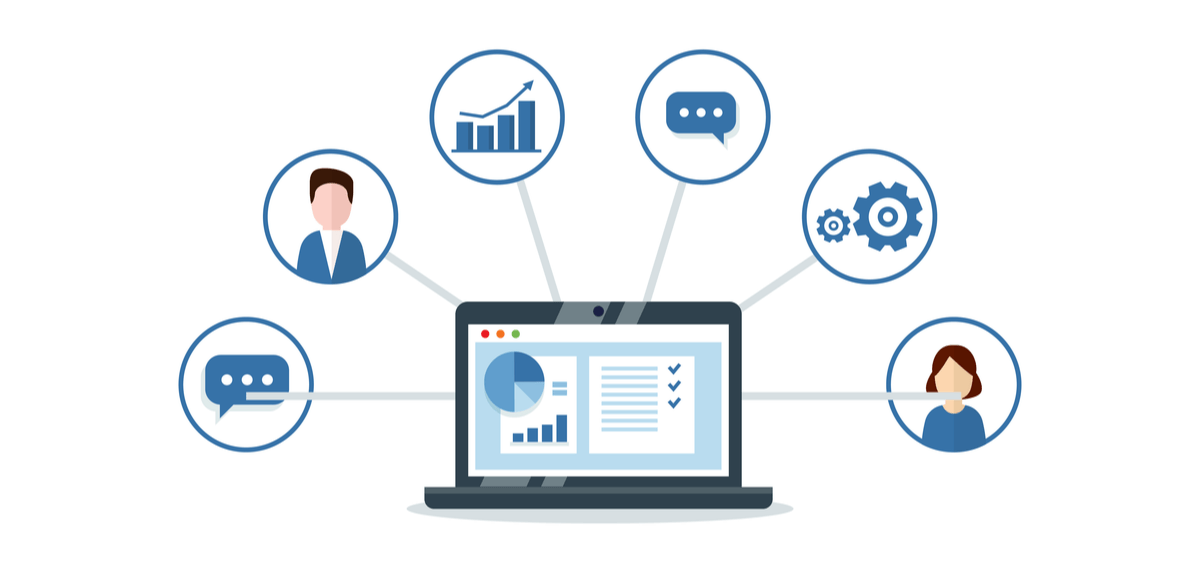Naturally, every business wants its customers to leave each interaction feeling happy and fulfilled. The benefits of having happy customers go beyond the moment! They’re wide-reaching and long-lasting. And they can even help your business grow.
The better your customers’ experience, the more likely they are to return for more and become loyal customers. This matters because research shows that loyal customers make more repeat purchases, tend to buy more, and make referrals to their friends and family.
But you can only get there by having the mindset, vision and processes in place that all support the broader goal of generating happy, satisfied customers.
We want to help you create a solid strategy for generating customer happiness, so we’ve put together this guide to help you create a solid customer service strategy that wins every time.
By following these simple seven steps, you can revamp your approach to customer service and transform your approach to customer happiness.
1. Know Your End Goal: Customer Happiness

In order to achieve customer satisfaction, first, you must define what exactly that means to your business in a broader sense, so that you can then set tangible goals against it.
This begins with thinking about your mission around customer service and how you can bring that mission to life by instilling company values that support it. Keeping customer happiness front and centre as your overarching company mission will enable your entire organisation to be on the same page regarding its purpose. This will make certain that all business activities relate back to ensuring that you are prioritising keeping your customers happy.
Your commitment to customer happiness should drive your company’s offerings and the ways in which it provides support. By defining that vision and baking it into your company’s operations, customer happiness will be the ‘red thread’ that ties everything your company does together into one cohesive package.
2. Set Customer Service Goals
Goal setting is the series of more granular actions that support your company’s big vision. While the main goal is customer happiness, this is achieved by breaking it down into smaller, more tangible goals.
Once your company’s leadership understands and defines its vision for customer happiness, it should be communicated to the rest of the team by setting goals for them. The goals you set should be SMART.
- Specific
- Measurable
- Achievable
- Relevant and within a specific
- Timeframe
What does this look like for your team? Consider the following: you start with a vision of what you want to achieve by upgrading your customer service programme, and then you work with your team to make a series of smaller, specific goals that are challenging yet achievable, relevant to the larger objective of generating happy customers, and measurable to a specific time frame associated with each goal.
For example, it could be that your customer feedback shows that customers who receive a quick response to their query have been shown to be happiest with your product or service. This type of customer feedback is a good starting point, given that speed of response is key for modern customer service, with 88% of customers saying they expect a response from your business within 60 minutes.
Based on that premise, you might therefore set a goal to ensure that, in the next three months, your team will commit to ensuring they respond to each customer within two hours at the latest, but ideally aiming to respond within the first hour. This type of goal is specific, achievable, timely, and relevant to the ultimate goal of generating happy customers.
If you start with specific goals in mind, it gives you a base from which to implement the actions that will help your team achieve the specific goals tied to the bigger picture, which is customer happiness.
You should give your employees tangible ways of achieving these goals and check in to implement reviews periodically so that you can assess how progress against the goals is coming along. Along the way, always make sure you share your larger vision of customer happiness with the entire team so that everyone knows that their smaller goals work towards meeting the larger objective of customer happiness.
This motivates employees, giving them a broader purpose that they know their individual work is helping achieve. By helping give your people a ‘why’, you’ll create cohesion and pride amongst your team members, which goes a long way towards making customers happy.
3. Identify Customer Touchpoints

Customer touchpoints are the ‘how’ and ‘where’ customers interact with your brand, product, or service. Examples of touchpoints include email, phone, chat/messenger, and social media.
To improve customer happiness, it’s important to know which touchpoints your customers are using to contact your company, so that you can make sure to meet them there. Understanding and actioning each touchpoint with the appropriate customer service response allows you to design better customer experiences.
This means you’ll need to make sure you have a joined-up, powerful customer service toolkit that your representatives are trained on and can easily use. Most customer service representatives are juggling multiple conversations and channels at once, and 72% of customers say they typically have to explain their problem to multiple people.
So as you can see, neglecting to implement a streamlined solution that joins up all touchpoints does everyone a disservice. By providing an omnichannel solution, you’ll be making their job easier, as well as ensuring your customers get the best service possible.
A customer service CRM can be helpful here because it will unify all the different touchpoints under one digital ‘roof’ so that your representatives can have centralised access to customer enquiries via phone, chat, or social media without having to move from channel to channel.
Centralising your customer touchpoints ensures that all customer information is in one place, streamlined so that your team is empowered to help customers as effectively as possible.
4. Build an Effective and Efficient Customer Service Team
After you’ve identified your customer happiness goals and are ready to put them into practice, you want to make sure you have a skilled, motivated team ready to tackle each one. This starts by building a team that is aligned with your company’s mission of driving customer happiness through its actions.
The interview process should explain your company’s mission and ask candidates if they feel they can commit to supporting this mission in how they undertake their work. Cultural fit is important to make sure that the employee understands and works in alignment with the company values.
Once you’ve made a hire, the next step is to train new employees to empower them with the hard and soft skills they’ll need to succeed in the role. This means providing training around how the output of their role works directly towards your goal of ensuring customer happiness and training them on how to use your internal technology and tools to deliver it.
Every employee should be given the same training so that everyone is on the same page about what you’re all aiming to achieve at the company: customer happiness. Making people feel like they are part of a passionate team dedicated to creating positive customer interactions goes a long way to maintaining high morale – and that will shine through in everything an employee does.
5. Empower Your Customer Service Team
It’s not enough to just build a great team — you also need to empower them to give them the wings to do their best work. Building a ‘dream team’ of customer service representatives is all about giving them the support and tools they need to do the job to the best of their ability.
If your processes make it difficult for your team to do their job effectively, it will be frustrating and demoralising to them, leading to negative outcomes all around.
Things like complex approval processes, an inability to offer discounts, or a general lack of authority prevent your team from having the full toolkit they need to do an excellent job.
Think about how you can change your internal policies to give your team the power to do their job more efficiently and service your customers better. Sometimes, simply giving your team more flexibility to take ownership of a situation or to think outside the box can result in improved problem solving.
The bottom line is that if you want a superhero customer service team, you have to give them enough support and authority to be able to act in the best interests of your customers. By tweaking your policies to take this into consideration, you’ll endow your team with the best chances of success.
6. Centralise Your Customer Data

Customer data is one of the most useful ways of providing good customer support, but that data is no good if it’s kept in a silo, particularly if your team has to search through different spreadsheets, dashboards or files to find the information they need to help a customer. This will only result in a stressed customer service team and exasperated customers.
This is why centralising data is so important. One way of doing this is by employing an ecommerce help desk or other customer dashboard, which can take all of a customer’s touchpoints, such as emails, phone call records, and social media messages, and centralise them in one place.
Doing so will enable your customer service team to always be able to call upon any historical information about a customer’s purchase or experience without having to waste time digging. Imagine a customer speaking with a representative at your call centre, who already has at their fingertips the customer’s order history and previous messages with your company to provide historical context. With all the information at the ready, your team will be well-positioned to help customers in a timely and effective manner.
As you can see, streamlining your internal processes doesn’t just help your internal business, it helps your customers too, which in turn improves your overall business.
7. Track and Improve on Performance
Goal-setting is important but you also want to make sure you are taking the learnings and lessons learnt from the execution of those goals and apply them to future actions and improvements.
For example, every goal you set towards driving customer happiness will have outcomes. After a few months of implementing each goal, you can assess whether the output of the goal is driving the desired outcomes, or if improvement is needed.
This ensures that you never stay complacent and always continue to improve and innovate to keep setting the bar high for customer happiness.
The only way to know if your customer service strategy is giving your customers the support and satisfaction they need is by measuring it so that you can quantify your success in a logical and standardised manner.
A key way to do this is through customer satisfaction surveys, where your customers are invited to provide direct feedback about their experience with the support they were provided with. You can measure this on a scale of 1-10, with ten being happiest. Depending on the average score your customers provide, you’ll know whether further improvements to the execution of your goals are needed.
Final Thoughts
Monitoring your customer service strategy for lasting success is key. Once you define and develop your customer service strategy, you can keep your business moving forward towards greater success by improving upon your processes. This helps you build positive and profitable customer relationships that will continue to improve over time, along with the word of mouth about your company and its customer service.
As with anything, you never want to put processes in place to forget them or to become complacent. Always keep asking for feedback and evaluating against your measurement rubrics to stay on top of what’s working and what isn’t. After all, customer happiness is a journey, and you can (and should) always make adjustments as needed, based on what the data tells you. The more you improve, the more pleasant and fruitful that journey will be for everyone.
Discover a better way to do eCommerce customer support. eDesk helps 5,000+ online retailers including Right Deals UK centralize their customer messaging in one place to resolve faster and create happier customers. Book a live demo at a time that suits you to learn more.






